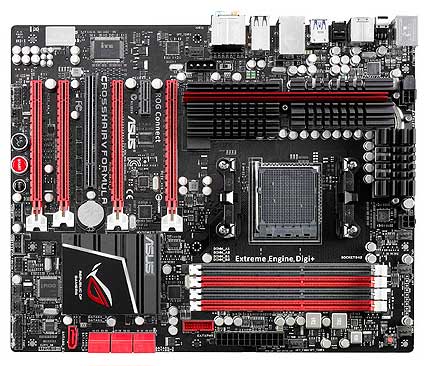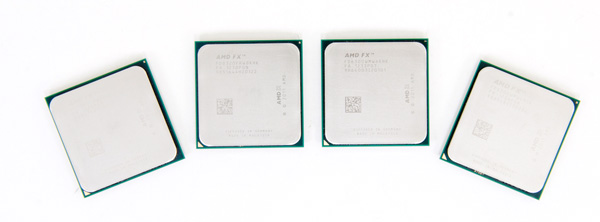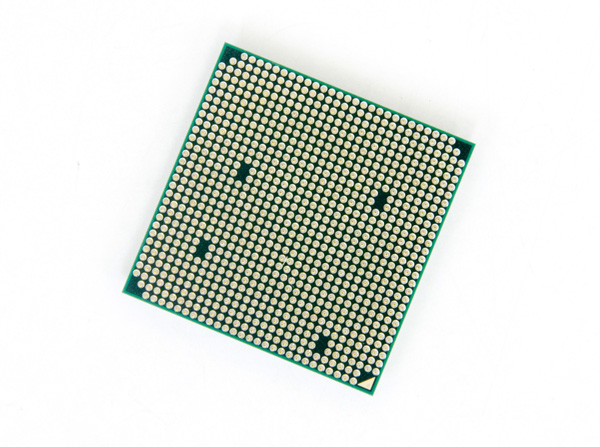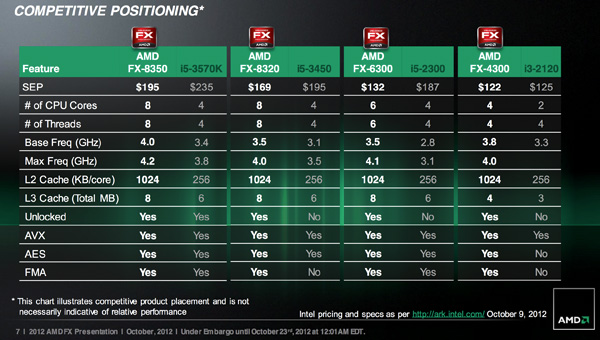The Vishera Review: AMD FX-8350, FX-8320, FX-6300 and FX-4300 Tested
by Anand Lal Shimpi on October 23, 2012 12:00 AM ESTLast year's launch of AMD's FX processors was honestly disappointing. The Bulldozer CPU cores that were bundled into each Zambezi chip were hardly power efficient and in many areas couldn't significantly outperform AMD's previous generation platform. Look beyond the direct AMD comparison and the situation looked even worse. In our conclusion to last year's FX-8150 review I wrote the following:
"Single threaded performance is my biggest concern, and compared to Sandy Bridge there's a good 40-50% advantage the i5 2500K enjoys over the FX-8150. My hope is that future derivatives of the FX processor (perhaps based on Piledriver) will boast much more aggressive Turbo Core frequencies, which would do wonders at eating into that advantage."
The performance advantage that Intel enjoyed at the time was beyond what could be erased by a single generation. To make matters worse, before AMD could rev Bulldozer, Intel already began shipping Ivy Bridge - a part that not only increased performance but decreased power consumption as well. It's been a rough road for AMD over these past few years, but you have to give credit where it's due: we haven't seen AMD executing this consistently in quite a while. As promised we've now had multiple generations of each platform ship from AMD. Brazos had a mild update, Llano paved the way for Trinity which is now shipping, and around a year after Zambezi's launch we have Vishera: the Piledriver based AMD FX successor.
At a high level, Vishera swaps out the Bulldozer cores from Zambezi and replaces them with Piledriver. This is the same CPU core that is used in Trinity, but it's optimized for a very different purpose here in Vishera. While Trinity had to worry about working nicely in a laptop, Vishera is strictly a high-end desktop/workstation part. There's no on-die graphics for starters. Clock speeds and TDPs are also up compared to Trinity.
| CPU Specification Comparison | ||||||||
| CPU | Manufacturing Process | Cores | Transistor Count | Die Size | ||||
| AMD Vishera 8C | 32nm | 8 | 1.2B | 315mm2 | ||||
| AMD Zambezi 8C | 32nm | 8 | 1.2B | 315mm2 | ||||
| Intel Ivy Bridge 4C | 22nm | 4 | 1.4B | 160mm2 | ||||
| Intel Sandy Bridge E (6C) | 32nm | 6 | 2.27B | 435mm2 | ||||
| Intel Sandy Bridge E (4C) | 32nm | 4 | 1.27B | 294mm2 | ||||
| Intel Sandy Bridge 4C | 32nm | 4 | 1.16B | 216mm2 | ||||
| Intel Lynnfield 4C | 45nm | 4 | 774M | 296mm2 | ||||
| Intel Sandy Bridge 2C (GT1) | 32nm | 2 | 504M | 131mm2 | ||||
| Intel Sandy Bridge 2C (GT2) | 32nm | 2 | 624M | 149mm2 | ||||
Vishera is still built on the same 32nm GlobalFoundries SOI process as Zambezi, which means there isn't much room for additional architectural complexity without ballooning die area, and not a whole lot of hope for significantly decreasing power consumption. As a fabless semiconductor manufacturer, AMD is now at GF's mercy when it comes to moving process technology forward. It simply has to make 32nm work for now. Piledriver is a light evolution over Bulldozer, so there's actually no substantial increase in die area compared to the previous generation. Cache sizes remain the same as well, which keeps everything roughly the same. These chips are obviously much larger than Intel's 22nm Ivy Bridge parts, but Intel has a full node advantage there which enables that.
Piledriver is a bit more power efficient than Bulldozer, which enables AMD to drive Vishera's frequency up while remaining in the same thermal envelope as Zambezi. The new lineup is in the table below:
| CPU Specification Comparison | ||||||||||
| Processor | Codename | Cores | Clock Speed | Max Turbo | L2/L3 Cache | TDP | Price | |||
| AMD FX-8350 | Vishera | 8 | 4.0GHz | 4.2GHz | 8MB/8MB | 125W | $199 | |||
| AMD FX-8150 | Zambezi | 8 | 3.6GHz | 4.2GHz | 8MB/8MB | 125W | $183 | |||
| AMD FX-8320 | Vishera | 8 | 3.5GHz | 4.0GHz | 8MB/8MB | 125W | $169 | |||
| AMD FX-8120 | Zambezi | 8 | 3.1GHz | 4.0GHz | 8MB/8MB | 125W | $153 | |||
| AMD FX-6300 | Vishera | 6 | 3.5GHz | 4.1GHz | 6MB/8MB | 95W | $132 | |||
| AMD FX-6100 | Zambezi | 6 | 3.3GHz | 3.9GHz | 6MB/8MB | 95W | $112 | |||
| AMD FX-4300 | Vishera | 4 | 3.8GHz | 4.0GHz | 4MB/4MB | 95W | $122 | |||
| AMD FX-4100 | Zambezi | 4 | 3.6GHz | 3.8GHz | 4MB/4MB | 95W | $101 | |||
The table above says it all. TDPs haven't changed, cache sizes haven't changed and neither have core counts. Across the board Vishera ships at higher base frequencies than the equivalent Zambezi part, but without increasing max turbo frequency (in the case of the 8-core parts). The 6 and 4 core versions get boosts to both sides, without increasing TDP. In our Trinity notebook review I called the new CPU core Bulldozed Tuned. The table above supports that characterization.
It's also important to note that AMD's pricing this time around is far more sensible. While the FX-8150 debuted at $245, the 8350 drops that price to $199 putting it around $40 less than the Core i5 3570K. The chart below shows where AMD expects all of these CPUs to do battle:
AMD's targets are similar to what they were last time: Intel's Core i5 and below. All of the FX processors remain unlocked and ship fully featured with hardware AES acceleration enabled. Most Socket-AM3+ motherboards on the market today should support the new parts with nothing more than a BIOS update. In fact, I used the same ASUS Crosshair V Formula motherboard I used last year (with a much newer BIOS) for today's review:

The Test
For more comparisons be sure to check out our performance database: Bench.
| Motherboard: | ASUS Maximus V Gene (Intel Z77) ASUS Crosshair V Formula (AMD 990FX) |
| Hard Disk: | Intel X25-M SSD (80GB) Crucial RealSSD C300 OCZ Agility 3 (240GB) Samsung SSD 830 (512GB) |
| Memory: | 4 x 4GB G.Skill Ripjaws X DDR3-1600 9-9-9-20 |
| Video Card: | ATI Radeon HD 5870 (Windows 7) NVIDIA GeForce GTX 680 (Windows 8) |
| Desktop Resolution: | 1920 x 1200 |
| OS: | Windows 7 x64/Windows 8 Pro x64 |













250 Comments
View All Comments
CeriseCogburn - Tuesday, October 30, 2012 - link
LOL - seems like... hahahahhahahah in some imaginary future in a far off land, if and when and only if amd does xxxx and yyyyyy and blah blah blah blah,.... blew it.g101 - Wednesday, November 21, 2012 - link
More extreme ignorance from the idiot CeriseCogburn. Little boys who only game should seriously consider not commenting on things they aren't capable of comprehending.Stupid little bitchboy CeriseCogburn...What a waste of oxygen.
DDR4 - Wednesday, November 7, 2012 - link
nice to see AMD make better procs and lower their pricesandrewkoch - Friday, November 9, 2012 - link
If you live in an area that requires A/C most of the year like me, the true cost of owning a FX8350 processor is about an additional $100 year vs. owing a 3570k.Fx8350 +15 watts idle +95 watts load vs. i5 3570k
50 hours week light cpu usage = 75W
10 hours week heavy cpu usage = 760w
Combined usage = 1025w @$0.11 Kw/h = $1.12
A/C usage 75%-80% @$0.11 Kw/h = $.84
Extra electrical cost $2/week
Extra electrical cost $100/yearly or $300/3 years
Maybe my math is wrong, but if you use A/C most of the year and pay for electricity an AMD cpu is a waste of money. Then again some people still use incandescent light bulbs instead of compact fluorescent lamps or LED bulbs.
andrewkoch - Saturday, November 10, 2012 - link
LoL my math was wrong in the above post.Fx8350 +15 watts idle +95 watts load vs. i5 3570k
68 hours week light cpu usage = 1kW
100 hours week heavy cpu usage = 9.5w
Combined weekly usage = 10.5kw @$0.11 Kw/h = $01.15
Average A/C usage 80%*$1.15 @$0.11 Kw/h = $.0.92
Extra electrical cost $2/week vs. owing a 3570k
Extra electrical cost $100/yearly or $300/3 years vs. owing a 3570k
In this usage scenario the computer is heavily used for tasks like folding, gaming or video editing
criter - Saturday, November 17, 2012 - link
121117Intel is a semiconductor company first; and a microprocessor company second ($13.5B revenue [#3.8B quarter])
used to make a living making memory chips (dram) until they became commoditized by Japanese rivals in the 1980s and margins plunged, now volume produced microprocessors happen to be the most profitable;
makes more useable chips per $5B-300mm & $7B-450mm/+40to120% extra chips wafer fabs, (90% yield range vs 60 to 80% rivals), moving to 22nm geometries, 14nm by 4q13;
Chips take about 3 months to make and they are put through more than 300 separate processes
intel atom vs brit arm (less pwr & customizable, 98% of cellphones since 2005 have had arms in them) for touch panel (w8) mobile/cell phone/tablet mkt
i3 55W ceiling...
amd Piledriver (x86 architecture) retail Oct 2012, 4c, 8c, L2&3 16MB, am3+, ddr3, dx11, 32nm; 1st gen Zambezi; (pdriver performs +15% than bulldozer;)
FX4300 8MB/95w, 3.8GHz, $131, 4c
FX6300 14MB/95w, 3.5GHz, $176, 6c
fx8320 16MB/125w, 3.5GHz, $242, 8c
fx8350 16MB/125w, 4GHz, $253, 8c
K10 4q07 (phenom x4/IIx3/IIx4, gen3 Opteron), K8 2q03 (Athlon 64/64x2, Sempron 64), k7 3q99 (Athlon/xp, Duron, Sempron)
?Trinity apu (AcceleratedProcessingUnit, pdriver) architecture (2gen x86 cores) Oct 1, integrated gpu, 'fusion' fm2 formfactor (previous llano use fm1 socket), dx11 (shader5), (radion A4-7480 to A10-7660 hd gpu)
Merom mobile arch (1q06, 667-800MT/s, 35W, bga479, socketM&P; updated 65nm [fab] Yonah core P6[pentium pro '95]) marked Intel’s acknowledging that the Pentium 4 (netburst arch) was not a viable long term solution because power efficiency is crucial to success;
65nm Conroe desktop (core2 quad, 800 MT/s, 65W, lga775); Woodcrest (lga771) 1333 scaled down to 1066MT/s workstation (40W@1.6-1.86GHz, 80W 3GHz), server(xeon socket604&lga771);
differing socket(M,P,T,fcbga), bus speed and pwr consumption; the identical Core microarchitecture was designed by Israel's Intel Israel (IDC) team;
stepping represent incremental improvements but also different sets of features like cache size and low power modes;
Nehalem 45nm (16pipeline), Westmere 32nm; Sandy bridge 32nm, ivy bridg 22nm; Haswell 22nm, Broadwell 14nm; Skylake 14nm, Skymont 10nm;
sandy bridge 32nm integrated x86 microprocessor as SoC (cpu/gpu+last lvl cache+sys I/O) vs amd bulldozer
intel haswell dual-threaded, out-of-order cpu arch 22nm FinFET, (high end tablets, low pwr)
theoretical peak performance for Haswell is over double that of Sandy Bridge, twice the FLOP/s, cache bandwidth doubled, vs '13 amd Steamroller core & w8;
g101 - Wednesday, November 21, 2012 - link
What is this pile of copy/pasted shit?Principle - Thursday, November 29, 2012 - link
Why is it that every review I see, no one uses the RAM that the CPU memory controller is rated for? Or in overclocking, did you see what a RAM overclock added?Just because your Intel chip may not perform any better with 1333, 1600, or 1866, doesnt mean you dont run your AMD chip with the 1866 its rated for. I see this all over the review sites. You dont have to use the same RAM in both systems for a comparison of CPU performance. RAM choice is designed into the CPU, and has an affect.
ThaSpacePope - Monday, December 3, 2012 - link
Nice job AMD. I guess some of these benchmarks are skewed because windows 8 is superior to windows 7 because it uses the modules better, but still.. the $166 8350 outperforms in some cases or comes close to the performance of a $200 i5-3570k.This is great news for AMD. Keep up the good work!
jreyes2254 - Thursday, December 20, 2012 - link
I find it funny all the Intel lovers are hating on so called AMD "fanboys."Isnt defending Intel and hating on AMD in turn make you all Intel "Fanboys."?
...Intel has not served me well I havent used one since my ol P4... I gladly claim the title of AMD "Fanboy.".
I have this CPU, Its pretty Epic.